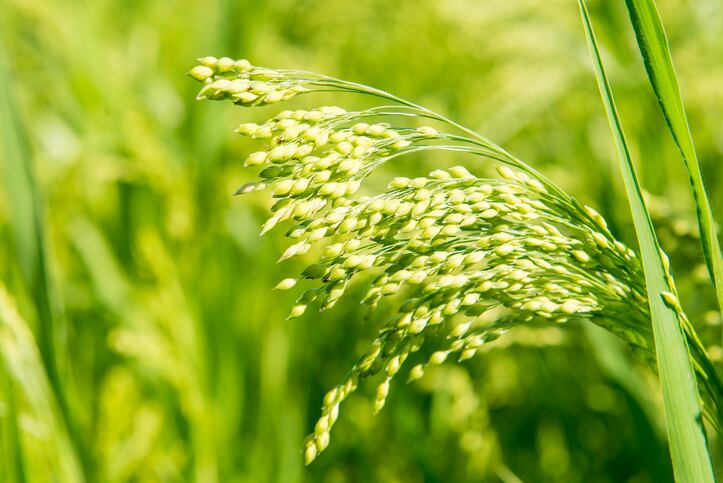The Food & Agriculture Organisation (FAO) declared 2023 to be the year of the millets. These ancient grain varieties can grow in both very poor and fertile soils and do not heavily deplete soil nutrients. On top of their nutritional benefits, these qualities make millets an ideal solution for countries to increase self-sufficiency and reduce reliance on imported cereal grains.
Gluten-free global food producer Dr. Schär has responded to this 'call to action' by investing in the development of VItaMi – Varietà Italiane di Miglio – a project that aims to select new millet varieties adapted to European soil and climatic conditions.
Millet is a naturally gluten-free cereal. It has a high fibre, calcium and iron content along with a growth short cycle. It is tolerant to climatic stresses (heat and drought), pests and diseases. These characteristics make it a nutritious, sustainable food source but also an opportunity to meet diverse dietary needs and support economic growth.
“Today, Italy and Europe in general are suffering from increasingly critical climatic conditions, and millet is a resilient, adaptable crop,” explained Ombretta Polenghi, Director of Global Research & Innovation at Dr. Schär. VitaMì‘s goal therefore is to obtain new, high quality millet varieties with improved agronomic, technological and nutritional characteristics, to be included in the supply chain, she said, and “capable of responding not only to the new demands of an ever-changing environment and growing areas, but also to the needs of our consumers who have to follow a gluten-free diet.”
Despite many health benefits, millets also contain antinutrients such as phytic acid that block or reduce your body’s absorption of other nutrients and may lead to deficiencies. Phytates are mostly found in millet hulls, however, which are removed for human consumption, and a person with a balanced diet is in any case unliley likely to experience adverse effects. What’s more, of the multiple types of millets, Dr. Schär has chosen to grow proso millet which has one of the lowest phytate contents.
This variety, as well as boasting a high content of vitamins; iron; and minerals is “highly tolerant to drought conditions and to heatwaves which here in Southern Europe we have more and more frequently”, explained Dr. Schär’s, Global R&I Manager, Silvano Ciani.
Why is millet back on growers radar?
- Millets can grow in both very poor and fertile soils and do not heavily deplete soil nutrients. By providing land cover in arid areas, they also help to reduce soil degradation and support biodiversity and sustainable land restoration.
- Millet is a naturally gluten-free cereal. It has a high fibre, calcium and iron content along with a growth short cycle. It is tolerant to climatic stresses (heat and drought), pests and diseases. These characteristics make it a nutritious, sustainable food source.
- It can be grown on marginal land so won’t displace other crops
- Millet can contribute vastly to a food secure world and ease grain shortages caused by recent conflicts and a changing climate.
Why we abandoned millet
Millets are no secret, though. An ancient grain consumed by humans up to 7,000 years ago, evidence shows that they played a pivotal role in the rise of multi-crop agriculture and settled farming societies, which were the very foundation of human civilisation.
“Proso millet was part of the diet in southern Europe up to when corn and maize substituted it in the early 1900s," explained Ciani. "Lots of dishes like polenta were made with proso millet. The Romans had it in their bread. So we were used to it, but we lost it. We lost it when modern farming concluded that corn and wheat were more productive.”
Corn and wheat yields can now reach up to 20 tonnes per hectare in the most productive environments compared to around two tonnes per hectare of millet. “It's a crop that's basically been abandoned so we have taken in ourselves to start this breeding project and to select new varieties that are well adapted to our growing environments.“
Dr. Schär hopes its breeding programme, which started in in 2020 at locations in Italy and Poland, will now redress the balance and ‘significantly‘ boost millet yields.
In 2022, the first field trials and the initial selection and evaluation of the best lines began. The project has so far cultivated around 6,000 millet lines from four different crosses, with 1,000 plants selected to be brought into the field.
A ‘thorough and meticulous analysis process‘ will continue over the next few years with the aim of distributing the first seed to farmers in 2025, and including the seed in the supply chain in 2026.
According to the company, the project is all in the name of biodiversity. Today, 40% of plant species are at risk of extinction. Rapid climate change, drought, deforestation, urbanisation, pollution and intensive monoculture are among the main causes of this impoverishment.
Dr. Schär, like other large producers, is therefore committed to preserving it by protecting and promoting minor crops such as sorghum, buckwheat, and millet.
The ultimate goal of this project is to obtain new, high quality millet varieties with improved agronomic, technological and nutritional characteristics, to be included in the supply chain, and capable of responding to the new demands of an ever-changing environment.


